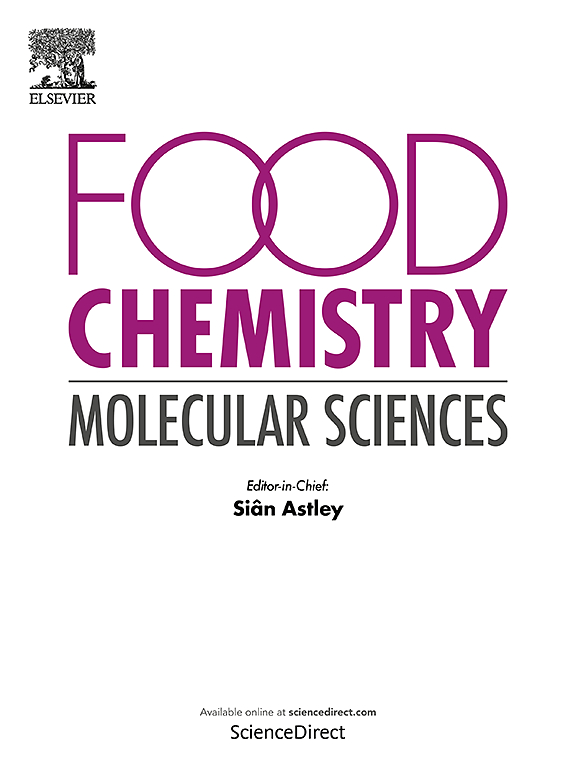What do microRNA concentrations tell us about the mechanical damage and storage period of strawberry fruits?
IF 4.1
Q2 FOOD SCIENCE & TECHNOLOGY
引用次数: 0
Abstract
Although much research has been performed to investigate the effects of storage conditions, such as mechanical damage and storage period, on the morphological and physiological properties of strawberry fruits, almost all of them have considered severe stress conditions. Finding fruit characteristics that exert significant changes even toward mild and moderate stress conditions can help provide valuable information about the fruit quality during storage. This study aims to investigate various characteristics of strawberry fruits during storage to determine which type of fruit characteristics exert such significant changes toward stress conditions. Identical strawberry samples were subjected to mechanical loading at three levels (1, 2, and 3 N) and then stored at 6 °C for 13 days. Morphological and physiological features, as well as the concentration of several microRNAs involved in strawberry storage, were measured at three-day intervals. The effects of mechanical loading on morphological and physiological characteristics were not significant, while their effects were significant on miR-164, miR-167, and miR-399a. Moreover, while low correlation coefficients were observed between the fruit morphophysiological traits (< 0.6) toward storage conditions, high correlations were obtained between the concentrations of microRNAs. Instead of measuring the morphological and physiological characteristics of fruits, whose behavior is not generally specific toward the stresses, the results show that microRNA concentrations, which can be measured by an electrochemical biosensor, provide us with noteworthy information about fruit quality during storage. These small non-coding molecules exhibited remarkable responses even in mild and moderate stress conditions, making them reliable markers of fruit quality assessment.
microRNA浓度告诉我们草莓果实的机械损伤和贮藏期是什么?
尽管已有许多研究探讨了贮藏条件(如机械损伤和贮藏时间)对草莓果实形态和生理特性的影响,但几乎所有的研究都考虑了严重的胁迫条件。发现即使在轻度和中度胁迫条件下也会产生显著变化的水果特征,可以帮助提供有关储存期间水果质量的有价值信息。本研究旨在研究草莓果实在贮藏过程中的各种特性,以确定哪种类型的果实特性在逆境条件下会产生如此显著的变化。相同的草莓样品在三个水平(1、2和3 N)下进行机械加载,然后在6°C下保存13天。每隔三天测量草莓的形态和生理特征,以及与草莓储存有关的几种microrna的浓度。机械负荷对形态和生理特性的影响不显著,而对miR-164、miR-167和miR-399a的影响显著。果实形态生理性状(<;对于储存条件,microrna的浓度之间获得了高相关性。结果表明,通过电化学生物传感器测量的microRNA浓度,可以为我们提供贮藏期间果实品质的重要信息,而不是测量果实的形态和生理特征,这些特征的行为通常对胁迫不具有特异性。这些非编码小分子即使在轻度和中度胁迫条件下也表现出显著的反应,使其成为果实品质评价的可靠标记。
本文章由计算机程序翻译,如有差异,请以英文原文为准。
求助全文
约1分钟内获得全文
求助全文
来源期刊

Food Chemistry Molecular Sciences
Agricultural and Biological Sciences-Food Science
CiteScore
6.00
自引率
0.00%
发文量
83
审稿时长
82 days
期刊介绍:
Food Chemistry: Molecular Sciences is one of three companion journals to the highly respected Food Chemistry.
Food Chemistry: Molecular Sciences is an open access journal publishing research advancing the theory and practice of molecular sciences of foods.
The types of articles considered are original research articles, analytical methods, comprehensive reviews and commentaries.
Topics include:
Molecular sciences relating to major and minor components of food (nutrients and bioactives) and their physiological, sensory, flavour, and microbiological aspects; data must be sufficient to demonstrate relevance to foods and as consumed by humans
Changes in molecular composition or structure in foods occurring or induced during growth, distribution and processing (industrial or domestic) or as a result of human metabolism
Quality, safety, authenticity and traceability of foods and packaging materials
Valorisation of food waste arising from processing and exploitation of by-products
Molecular sciences of additives, contaminants including agro-chemicals, together with their metabolism, food fate and benefit: risk to human health
Novel analytical and computational (bioinformatics) methods related to foods as consumed, nutrients and bioactives, sensory, metabolic fate, and origins of foods. Articles must be concerned with new or novel methods or novel uses and must be applied to real-world samples to demonstrate robustness. Those dealing with significant improvements to existing methods or foods and commodities from different regions, and re-use of existing data will be considered, provided authors can establish sufficient originality.
 求助内容:
求助内容: 应助结果提醒方式:
应助结果提醒方式:


